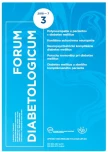Cardiac autonomic neuropathy as serious complication of diabetes mellitus
Authors:
Milan Kvapil; Barbora Pelechová; Pavlína Krollová; Šárka Malá
Authors‘ workplace:
Interní klinika 2. LF UK a FN Motol, Praha
Published in:
Forum Diab 2018; 7(3): 149-152
Category:
Review Article
Overview
Diabetic cardiac autonomic neuropathy (CAN) is one of the specific complications of diabetes. Its ethiology is multifactorial, the dominant influence is that of hyperglycemia, i.e. length of exposure to hyperglycemia. Clinical symptoms of cardiac autonomic neuropathy are not distinct: orthostatic hypotension and reduced tolerance of exercise. A typical manifestation is resting tachycardia, a serious complication is malignant arrhythmias. Regarding the diagnosis, we rely on the RR interval variability. The basis for therapy and prevention of the development of diabetic neuropathy is the intensification of diabetes treatment with the best possible compensation. Current medication therapy is, in large part, symptomatic only, with a focus on alleviating subjective problems. In view of the high incidence of adverse reactions, it is necessary to proceed rationally with this treatment. The only currently available active substance with a demonstrable effect on the pathophysiological processes that lead to diabetic neuropathy is thioctic acid. Prevention is a consistent treatment for hyperglycemia.
Key words:
diabetes mellitus, cardiac autonomic neuropathy, thioctic acid
Sources
1. Lacigová S, Rušavý Z, Jirkovská A et al. Doporučený postup diagnostiky a léčby diabetické neuropatie (2016). Diabetologie, metabolismus, endokrinologie, výživa 2016; 19(2): 57–63.
2. O‘Brien IA, McFadden JP, Corrall RJ. The influence of autonomic neuropathy on mortality in insulin-dependent diabetes. Q J Med 1991; 79(290): 495–502.
3. Maser RE, Lenhard MJ. Cardiovascular autonomic neuropathy due to diabetes mellitus: clinical manifestations, consequences, and treatment. J Clin Endocrinol Metab 2005; 90(10): 5896–5903
4. Spallone V, Ziegler D, Freeman R et al. Cardiovascular autonomic neuropathy in diabetes: clinical impact, assessment, diagnosis, and management. Diabetes Metab Res Rev 2011; 27(7): 639–653
5. Callaghan BC, Cheng HT, Stables CL, Smith AL, Feldman EL. Diabetic neuropathy: clinical manifestations and current treatments. Lancet Neurol 2012; 11(6): 521–534.
6. Spallone V, Bellavere F, Scionti L et al. [Diabetic Neuropathy Study Group of the Italian Society of Diabetology]. Recommendations for the use of cardiovascular tests in diagnosing diabetic autonomic neuropathy. Nutr Metab Cardiovasc Dis 2011; 21(1): 69–78.
7. Stern K, Cho YH, Benitez-Aguirre P et al. QT interval, corrected for heart rate, is associated with HbA1c concentration and autonomic function in diabetes. Diabet Med 2016; 33(10): 1415–1421.
8. Kumhar MR, Agarwal TD, Singh VB et al. Cardiac autonomic neuropathy and its correlation with QTc dispersion in type 2 diabetes. Indian Heart J 2000; 52(4): 421–426.
9. Pop-Busui R. Cardiac autonomic neuropathy in diabetes: a clinical perspective. Diabetes Care 2010; 33(2): 434–441.
10. Ewing DJ, Martyn CN, Young RJ et al. The value of cardiovascular autonomic function tests: 10 years experience in diabetes. Diabetes Care 1985; 8(5): 491–498.
11. Malá Š, Kvapil M. Význam kardiální autonomní neuropatie a hodnocení délky QT intervalu v její diagnostice. In: Kvapil M (ed). Diabetologie 2018. Triton; Praha 2018: 315–319.
12. Ziegler D, Schatz H, Conrad F et al. Effects of treatment with the antioxidant alpha-lipoic acid on cardiac autonomic neuropathy in NIDDM patients. A 4-month randomized controlled multicenter trial (DEKAN Study). Deutsche Kardiale Autonome Neuropathie. Diabetes Care 1997; 20(3): 369–373.
13. Callaghan BC, Little AA, Feldman EL, Hughes RA. Enhanced glucose control for preventing and treating diabetic neuropathy. Cochrane Database Syst Rev 2012; 13(6). CD007543. Dostupné z DOI: <http://doi: 10.1002/14651858.CD007543.pub2>.
14. Škrha J. Oxidační stres a jeho vztah ke komplikacím diabetu. Interní medicína pro praxi 2010; 12(9): 414–418.
15. Ziegler D, Nowak H, Kempler P et al. Treatment of symptomatic diabetic polyneuropathy with antioxidant α-lipoic acid: A meta-analysis. Diabet Med 2014; 21(2): 114–121.
16. Ziegler D, Low PA, Litchy WJ et al. Efficacy and safety of antioxidant treatment with α-lipoic acid over 4 years in diabetic polyneuropathy: the NATHAN 1 trial. Diabetes Care 2011; 34(9): 2054–2060.
17. Han T, Bai J, Liu W et al. A systematic review and meta-analysis of α-lipoic acid in the treatment of diabetic peripheral neuropathy. Eur J Endocrinol 2012; 167(4): 465–471.
Labels
Diabetology Endocrinology Internal medicineArticle was published in
Forum Diabetologicum

2018 Issue 3
Most read in this issue
- Polyneuropathies in patients with diabetes mellitus
- Balance disorders in the presence of diabetes mellitus
- Proximal diabetic amyotrophy: case reports
- Cardiac autonomic neuropathy as serious complication of diabetes mellitus
